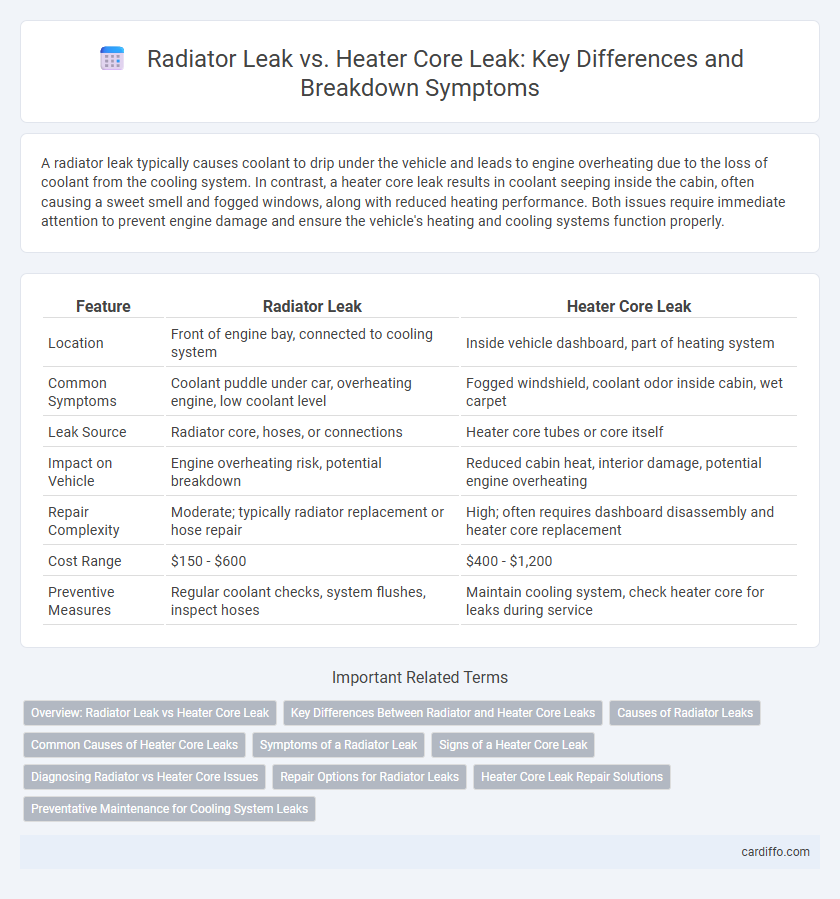A radiator leak typically causes coolant to drip under the vehicle and leads to engine overheating due to the loss of coolant from the cooling system. In contrast, a heater core leak results in coolant seeping inside the cabin, often causing a sweet smell and fogged windows, along with reduced heating performance. Both issues require immediate attention to prevent engine damage and ensure the vehicle's heating and cooling systems function properly.
Table of Comparison
| Feature | Radiator Leak | Heater Core Leak |
|---|---|---|
| Location | Front of engine bay, connected to cooling system | Inside vehicle dashboard, part of heating system |
| Common Symptoms | Coolant puddle under car, overheating engine, low coolant level | Fogged windshield, coolant odor inside cabin, wet carpet |
| Leak Source | Radiator core, hoses, or connections | Heater core tubes or core itself |
| Impact on Vehicle | Engine overheating risk, potential breakdown | Reduced cabin heat, interior damage, potential engine overheating |
| Repair Complexity | Moderate; typically radiator replacement or hose repair | High; often requires dashboard disassembly and heater core replacement |
| Cost Range | $150 - $600 | $400 - $1,200 |
| Preventive Measures | Regular coolant checks, system flushes, inspect hoses | Maintain cooling system, check heater core for leaks during service |
Overview: Radiator Leak vs Heater Core Leak
Radiator leaks typically occur in the main cooling component of a vehicle, causing coolant to escape and leading to engine overheating. Heater core leaks, on the other hand, happen within the vehicle's interior heating system, often resulting in a sweet-smelling fog inside the cabin or wet carpets. Both issues require prompt diagnosis and repair to prevent engine damage and ensure passenger comfort.
Key Differences Between Radiator and Heater Core Leaks
Radiator leaks primarily occur in the front of the vehicle and cause coolant to escape, leading to engine overheating and visible puddles under the car. Heater core leaks happen inside the cabin, often causing a sweet-smelling fog or damp carpets due to coolant leaking into the ventilation system. The key differences lie in the leak location, symptoms, and effects on vehicle heating versus engine cooling.
Causes of Radiator Leaks
Radiator leaks commonly result from corrosion caused by deteriorated coolant, physical damage from debris or road salt, and pressure buildup due to a faulty radiator cap. These leaks often appear at weakened spots such as seams, tanks, or hose connections, where metal fatigue or gasket failure occurs. Identifying the source accurately is crucial, as radiator leaks can lead to engine overheating and significant breakdowns if untreated.
Common Causes of Heater Core Leaks
Heater core leaks commonly result from corrosion caused by old or contaminated coolant, leading to the gradual deterioration of its metal components. Another frequent cause is physical damage due to vibrations or impacts within the vehicle's HVAC system, which weakens the heater core tubing. Poor maintenance, such as failing to regularly flush the cooling system, accelerates residue buildup and corrosion, increasing the risk of leaks.
Symptoms of a Radiator Leak
A radiator leak often causes visible coolant puddles under the vehicle and a noticeable drop in coolant levels without corresponding heater core symptoms like a foggy windshield or sweet-smelling air inside the cabin. Engine overheating is a common symptom due to reduced coolant circulation caused by the radiator leak. Unlike heater core leaks that primarily affect cabin temperature and comfort, radiator leaks primarily impact engine cooling efficiency and external fluid loss.
Signs of a Heater Core Leak
A heater core leak typically causes a sweet, antifreeze smell inside the vehicle and foggy windows due to coolant vapor. Drivers may notice damp carpets on the passenger side as coolant seeps from the core, along with inconsistent cabin heating or a complete loss of heat. Over time, low coolant levels from the leak can lead to engine overheating and severe mechanical damage if left unaddressed.
Diagnosing Radiator vs Heater Core Issues
Diagnosing radiator leaks involves inspecting the radiator for visible cracks, coolant pooling underneath the vehicle, and a sweet odor from antifreeze, while heater core leaks often cause fogging inside the cabin, damp carpets, and coolant smell inside the car. Pressure testing the cooling system can help pinpoint whether the issue originates from the radiator or the heater core by detecting drops in system pressure at different points. Understanding symptoms like engine overheating typically relates to radiator issues, whereas heater core leaks usually lead to interior heating problems and coolant loss.
Repair Options for Radiator Leaks
Radiator leaks often require repair options such as patching small punctures with epoxy or replacing damaged hoses to prevent coolant loss and engine overheating. In case of severe damage, radiator replacement is recommended to restore the cooling system's efficiency and avoid prolonged breakdowns. Regular inspection and maintenance can help detect radiator leaks early and ensure timely repairs, preventing costly engine damage.
Heater Core Leak Repair Solutions
Heater core leak repair solutions involve flushing the cooling system, replacing the faulty heater core, and sealing minor leaks with specialized antifreeze additives. Technicians often prioritize heater core replacement as a definitive fix due to the core's role in cabin heating and engine temperature regulation. Efficient repair prevents coolant loss, avoids fogging inside the vehicle, and maintains optimal HVAC performance.
Preventative Maintenance for Cooling System Leaks
Radiator leaks often stem from corrosion and pressure buildup, while heater core leaks typically result from internal corrosion or clogging, both causing coolant loss and overheating risks. Regular inspection of radiator hoses, clamps, and coolant levels combined with flushing the cooling system every 30,000 miles helps prevent leaks and extends component lifespan. Using high-quality antifreeze and monitoring engine temperature are critical steps in avoiding costly repairs related to radiator and heater core failures.
Radiator leak vs heater core leak Infographic

 cardiffo.com
cardiffo.com